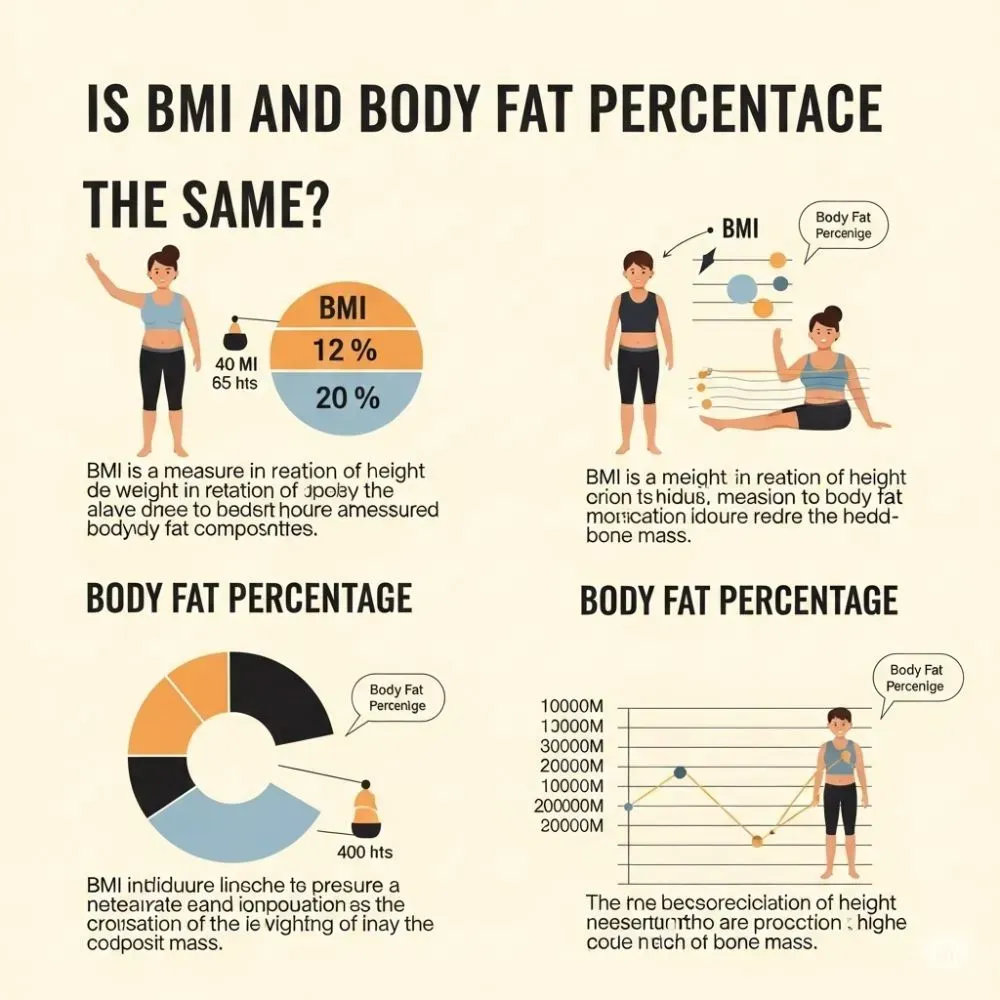Is BMI And Body Fat Percentage The Same? What Do They Mean for Your Health?
BMI and body fat percentage calculate very different things, though they evaluate your health and weight status.BMI is a quick calculation that only counts your height and weight. In contrast, body fat percentage provides in-depth information about how much fat you have in your body. Combining both helps you make better decisions about fitness, diet, and overall health.
In this blog, we will discuss the differences between BMI and body fat percentage, their similarities, accuracy, uses, and more. Keep reading to explore.

What is BMI?
Body Mass Index, also known as BMI, is a calculation method used to determine if someone has a healthy body weight for their height. Applying the formula kg/m² measures if someone is underweight, of normal weight, or overweight.
This method is popular due to its ease of computation.. It is a general indicator of health risks related to weight. Despite its widespread use, BMI isn’t a true measure of body fat.
A muscular person may have a high BMI. But it does not mean his/her body weight is unhealthy. Despite this limitation, BMI is still a useful indicator for general assessment.
What Is Body Fat Percentage?
Checking your body fat percentage reveals how much of your body consists of fat compared to muscle, organs, and bone. The process provides a clearer view than BMI and specifies if your body has a healthy amount of fat.
Body fat percentage is a crucial measurement for anyone because too high or too low a fat percentage can cause various health issues. A high body fat percentage is linked to a risk of serious health issues, including cardiovascular disease, type 2 diabetes, and high blood pressure. In contrast, extremely low body fat can cause hormonal imbalance, illness, and fatigue.
BMI vs. Body Fat Percentage: The Comparison
Though both methods aim to understand healthy body weight, they are different from many angles. This chart provides a clear overview of how they differ.
| Aspects | BMI | Body Fat Percentage |
|---|---|---|
| Indication | To know if you are underweight, normal, or overweight. | Your fitness level and fat distribution. |
| Complexity | Simple with using the formula: Weight (kg) / Height (m). | Calipers, BIA, and DEXA are used for fat percentage calculation. |
| Muscle mass consideration | BMI does not count muscle mass. | It considers muscle mass, too. |
Similarities Between BMI and Body Fat Percentage
Even with their differences, both still share some common purposes. Let's check out their similarities:
Both will inform you about body size and composition.- You can evaluate weight-related health risks.
- They will tell you if you are underweight, normal, overweight, or obese.
- Fitness professionals can guide you based on their results.
- They can help with the early detection of chronic conditions.
Which One Is More Accurate?
For accurate evaluation of body composition, body fat percentage is generally considered more reliable than BMI.. This is because fat percentage measurements give detailed insights while BMI shares basic information. However, both methods perform different functions and offer distinct advantages.
A limitation of BMI is that it relies solely on height and weight for body weight classifications. It overlooks factors such as muscle mass, bone density, and how fat is distributed throughout the body. Individuals with high muscle mass, like athletes, may be labeled overweight by BMI, even though they have low body fat.
.
On the other hand, body fat percentage provides in-depth information about your fitness level. It can distinguish how much fat and muscle you actually have. That's why body fat measurement is a better indicator for someone who aims to
reduce body fat percentage.
Why Do Both Metrics Matter for Your Health?
BMI and body fat rate are two separate calculations. But both still matter for several reasons. Let's discuss them briefly below:
⇰ Different Health Warnings: BMI offers a quick overview, like a warning about obesity. Your scale may show you're healthy, but body fat percentage can reveal underlying dangers such as excess visceral fat.
⇰ Smarter Planning:
An
in-person fitness trainer can use both to plan a personalized program for more accurate results. Thus, your workouts and diet can be better, and you can cleverly build muscle and reduce fat at once.
⇰ Better Health Monitoring:
You may not always see the body's changes on the scale. Your BMI or body fat percentage can be the same for years. However, it can be unhealthy from another angle. Combining both approaches can support long-term strength, vitality, and overall health as you grow older.
Final Words
If you solely depend on BMI or body fat percentage, you may miss the full picture. When using and tracking both, you can make smarter decisions about exercise and diet. Remember that your overall progress does not depend on just a number. It is connected with many factors that you may not even notice. If you find tracking your body weight and fat percentage challenging, talk to a fitness trainer who can simplify those metrics.
Frequently Asked Questions
Can you have a standard BMI but high body fat?
Yes. This situation is called skinny fat. Your body looks slim, but you still have a high body fat percentage, which increases the risk of health problems.
Why is BMI still used?
Because it is quick, easy, and widely accepted. This method is useful for general health screening, but not as precise for individuals.
Is body fat percentage more useful for fitness goals?
If your goal is to gain muscle or lose fat, it gives you more relevant and precise data than BMI.
Does body fat percentage change faster than BMI?
Yes. Fat loss and muscle growth can happen together, which may not show up as a lower weight. However, it will be reflected in a healthier body fat percentage.
How often should you check your BMI and body fat percentage?
Checking them every few months is enough. If you are super active or have a specific fitness goal, monthly tracking is advised to monitor your progress.



